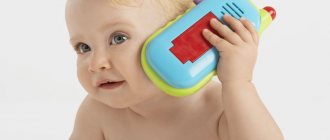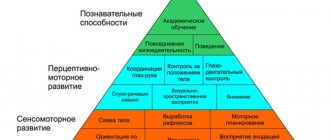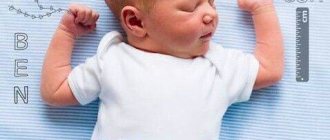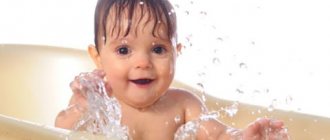In the first year, the child develops very quickly. New skills appear literally every day, and very often kids “produce” a whole range of innovations at once, making a real leap. The third month of a baby’s life is especially indicative in this regard.
The development of a child at 3 months is the result of everything that the baby has learned over time. After adaptation to new conditions and way of existence is completed, the child begins to actively study the world around him. His physical, mental, emotional and social development is entering an active phase.
We can highlight the main “achievements” that a child demonstrates at 3 months:
- Thanks to the intensive development of subcutaneous adipose tissue, a 3-month-old baby “rounds up”: his body becomes plump, cheeks and bandaging folds appear on the limbs.
- Physically, the baby acquires new skills. By 3 months, children master the ability to roll from back to tummy, and while lying on their stomach, they can rise up within a few minutes, leaning on their forearms.
- A semblance of a daily routine begins to emerge: the child begins to sleep and wake up at approximately the same hours, so it becomes easier for the mother to plan her day. DETAILS about the daily routine of a 3-month-old child by the hour.
- The period begins when the baby tries everything by heart.
Well, now let’s talk in more detail about child development in all areas.
Height and weight
The physical development of a child is always of great concern to both parents and pediatricians. Monthly visits to the clinic are accompanied not only by a general examination, but also by measuring weight and height. In general, the indicator of normal height and weight is very arbitrary. For a child of 3 months, you can roughly focus on the following figures:
- Weight 3-6 kg.
- Height 54-64 cm.
Height and weight are influenced by various factors: weight and height at birth, type of diet, genetics. The tables used by most pediatricians were developed by Soviet specialists and compiled on the basis of data on children receiving artificial formula.
height and weight gain table (click to enlarge)
Currently, many mothers are exclusively focused on breastfeeding, so the baby’s parameters may differ from the table numbers. For a pediatrician, this may be a reason to talk about underweight or excess body weight, but if you are breastfeeding, remember that during breastfeeding the gain can be from 0.5 to 2 kg. It is simply impossible to overfeed a child with breast milk; underfeeding is possible only if the feeding technique is impaired (how to breastfeed correctly). For example, if the mother does not allow the baby to be at the breast as much as he requires, or often changes breasts.
Mothers of infants should be calmer about discrepancies between the child’s height and weight and certain numbers. If the child is active, eats well, sleeps, actively explores the world around him, if he pees at least 12 times a day and poops 6-8 times, his hair and nails grow, then he is in perfect order.
Reflexes at three months
The baby's behavior and actions are regulated by reflexes and instincts. Most newborn reflexes fade away by 3 months. For example, at this age, the presence of the following reflexes may indicate neurological pathology:
- search reflex (in response to stroking the corner of the lips, the child turns his head towards the stimulus and opens his mouth);
- proboscis reflex (touching the upper lip causes the child to stretch out his lips in the form of a proboscis);
- Babkin's reflex (when you press your finger on the baby's palm, he opens his mouth and moves his head forward).
Some reflexes may still be preserved. For example, the Moro reflex, which is expressed in the fact that the child raises his arms and spreads his fingers when he is laid on his back or his legs are raised above the surface. This ancient reflex is evolutionarily developed to protect a child from falling.
But the sucking reflex and the crawling reflex are still very pronounced at 3 months, since they are directly involved in the survival and harmonious development of the child.
Read also: child's reflexes
New skills
Basic skills that are developed by 3 months:
- ability to roll over from back to side;
- the ability to raise the head and shoulders with support on the forearms;
- holds the head and controls it;
- recognizes the faces of mom and dad;
- laughs when communicating;
- is capricious and whining;
- grabs the toy and pulls it into the mouth;
- hums, coos;
- hits toys hanging over the crib with his hands;
- rests his legs on a hard surface with support under his arms.
There are no strict rules on this issue either. Some babies perform all these actions already at three months, while others begin to make their first attempts only closer to 4-5 months. Each little person has his own speed of development, so if the baby is healthy and does not have any neurological problems, he will definitely learn to roll over and lift himself up (when children begin to roll over).
By the way, the process of mastering new skills can be speeded up a little. The following tips will help parents with this:
- Add an exercise that stimulates inversions to your standard daily gymnastics. The baby lies on his back, his right leg needs to be lifted, holding it by the shin, and led to the left, as if throwing it over the body. This moment during a rollover is the most difficult for a child, because it is this moment that gives the whole body the impulse to perform the movement. Later, children learn to push off from a horizontal surface themselves.
- Conscientiously perform the entire range of exercises recommended by pediatricians. The basis of all new physical skills is the overall good development of the baby’s body and muscles.
- You can promote the development of the second skill in a very simple way: regularly place your baby on his stomach. To make lying in this position interesting, place bright toys in front of him. An excellent option for this age is a developmental mat. The baby will not be bored on it either on the back or on the tummy. Many rugs have a small round mirror included. Looking at your reflection there while lying on your stomach is a fascinating activity.
Detailed article: What a 3 month old baby can do
Another tip concerns safety: after the baby has learned to roll over, do not leave him alone on high surfaces (on the sofa or changing table). The baby may fall and get injured. If you need to leave the room, put your baby in a crib or chaise lounge.
Read also: How to teach a child to roll over
How to properly massage a baby
Do gymnastics. Ask your pediatrician about the dos and don'ts. And also do therapeutic massage. Don’t forget to add exercises to your gymnastics that will help you learn how to roll over from your back to your tummy.
It will be more fun to have massage and gymnastics along with nursery rhymes:
Development of the psyche and emotional sphere (mental development at three months)
Mental and emotional development by 3 months is also gaining momentum. First of all, the senses and basic mental functions develop very actively.
Vision
My vision has changed significantly. Now the child can follow a moving toy with his gaze and is able to peer into an object. This means that the baby develops object perception: he begins to perceive the object as a complex of properties, and the more senses he can perceive the object, the more information about the object of observation he will receive. That is why kids love not only to look at, but also to try to bite or lick everything that gets into their hands.
Hearing
The child’s hearing also develops and improves. At the age of 3 months, the baby already perfectly identifies different sounds from the general background, can accurately determine the source of the sound, and, of course, already knows his native voices very well. At the mother’s voice, the baby turns his head in her direction and smiles.
Sensation and perception for a 3-month-old child are the main mental processes through which the study of the surrounding world occurs. These two processes occur in all spheres of feeling: vision, hearing, smell, touch. The baby really likes to touch different surfaces and objects with his fingers, lick rattles, look at pictures and people’s faces, and enjoy different sounds.
Huge progress has also been made in the emotional sphere. At 3 months, children begin to give their first conscious smiles, the most sincere and open. The main innovation of this age is the “revitalization complex” - a strong emotional reaction that a child demonstrates when a close adult appears. The “revitalization complex” manifests itself not only in smiles. The baby begins to actively walk, move his arms and legs, showing in every way how happy he is to see his loved one.
Games and toys for children aged 3 months (how to entertain)
A three-month-old child can perceive rhymes or music for about 3-5 minutes. Toys attract him, he reaches out to them, tries to grab them. Play with him, give him an object and pull it as if you were taking it. Tell him during a walk everything that is happening around him if he is not sleeping. Little ones love nursery rhymes that we inherited from our grandmothers - for example, the “white-sided magpie.”
Make a double-sided plate doll, on which draw faces with different facial expressions on different sides. Kids love to watch the faces change when you turn the plate in front of their eyes. He should see both sad and joyful expressions. This toy will be very interesting for the baby. Show your child pictures, name objects, and accompany their images with animal sounds. Remember the main rules - clean toys and no sharp edges.
Nutrition and sleep
As we have already said, by three months a daily routine begins to form. This regime will change several times, but for the mother there is already some certainty and the opportunity to plan her affairs. Basically, the baby, like a newborn baby, spends time eating and sleeping, but periods of active wakefulness already appear. The main questions in this regard: how much does a three-month-old baby eat and sleep?
Sleep, as before, takes up most of the day. At this age, children sleep up to 17 hours in total. Typically, 9-10 hours of these occur at night, and the rest are distributed over 4 naps during the day.
There's a lot to say about food, but we'll focus on the main points.
If the child’s food is formula from a bottle, then the mode and volume of feedings is determined by the recommendations of the manufacturers of the adapted formula. Breastfed babies suckle on demand and stay at the breast as long as they need it.
For breastfeeding mothers, it will be useful to know that 3 months is the time of growth spurt and lactation crisis. This is a kind of turning point that is very important to pass successfully.
Read also: All about breastfeeding
The baby is actively exploring the world, so latching on to the breast may be difficult.
Many mothers say that the baby begins to spin around, look around and look at everything around, distracted from the breast. Without knowing about such features, the mother may interpret the baby’s restless behavior at the breast and the absence of hot flashes as a lack of milk and begin supplementing with formula. You shouldn't do this. During the most critical period, which lasts only a couple of days, it is better to focus on the baby and constantly offer the breast, putting aside all household and personal matters - this will help maintain lactation and successfully overcome the difficult moment.
Old-school pediatricians and loving grandmothers often begin to insist on introducing complementary foods at 3 months of age. Usually we are talking about apple juice, and then puree. For breastfed children, these recommendations are no longer relevant.
Read also: When to introduce the first complementary foods
Nutrition for a 3 month old baby
Doctors recommend feeding children of this age exclusively with breast milk or infant formula . Typically the number of feedings is 6-10 during the day and 2-4 at night. The time interval between feedings does not exceed 2-2.5 hours. Meals must be organized very well. High-quality formulas are selected individually by the pediatrician, and when breastfeeding, the mother must follow a strict diet.
Many mothers can start complementary feeding at this age on the advice of grandmothers and old-school pediatricians. This is completely wrong! In the third month of life, children’s gastrointestinal tract is not yet strong enough to digest anything other than special food. According to the recommendations of WHO doctors, it is necessary to think about complementary feeding no earlier than when the child is 6 months old.
What to do with your baby: games with your child
During moments of active wakefulness, the baby is no longer interested in just lying in the crib. An inquisitive toddler strives to see and hear something new and interesting.
Games at this age are quite simple and short. It's great if the game is accompanied by a fun nursery rhyme or just a poem. The fact is that at 3 months speech begins to develop. The child makes the first sounds, which in scientific language are called pre-speech vocalizations. These are long vowel sounds: u-u-u, a-a-a, uh-uh. For the full development of speech, it is simply necessary to hear words and sounds. Folklore works are perfect for babies, because they were specially composed by our ancestors and are always chanted.
As part of the game, you can do finger exercises, massage the palms and feet, or invite the baby to touch different textures (pieces of fabric, cereal, etc.) with his hand. Playing with a rattle is also a great option for 3 months.
You can invite your child to look at large pictures in a book, making sure to pronounce and name all the objects and details. The pictures themselves for this age should be very sketchy and simple.
Communication with your child is important not only during games. Conversations with your baby must accompany every contact with him, be it getting dressed for a walk or changing a diaper. The speech should be emotional and calm. For a child, this is not only a way of development, but also an indicator of mother’s love and acceptance, and this is even more important than new information and skills.
← 2 month 4 month →
Physiology
It is important to monitor proper physiological development. Throughout the entire 3rd month of life, the baby should gain weight from 800 g. The total weight of a child of this age can range from 6 to 8 kg for a boy and from 4.5 to 7.5 kg for a girl.
The child's growth has also changed significantly. Usually in the 3rd month the baby gains from 1 to 2 centimeters. The height of babies in this period can be from 56 to 65 cm. It should be remembered that short growth can be due to heredity, as well as the fact that the baby was born prematurely or twins were born.
Another important parameter is head circumference. For boys, the head circumference at 3 months is from 38 to 43 cm, and for girls - from 37 to 42 cm. You can notice that closer to the fourth month the head and chest circumferences are almost equal.
Of course, you cannot blindly rely on these numbers, but they should become some kind of guideline. It is necessary to monitor the physical development of the baby in more detail together with a pediatrician. Visits to the clinic in the first year of life should be regular.






